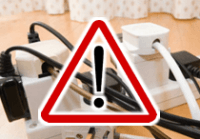Overcurrent Protection

Mains Delay for Overcurrent Protection
Mains Delay for Overcurrent Protection
Before a couple of years a problem raised when a team of computer devices where connected to the mains simultaneously. All the devices were connected on the same surge. Suddenly the main fuse was falling and everything was going dark. The problem of this mess was the electrolytic capacitors that were connected at the rectifier stage of the switching power supply of every device. When all these power supplies were connected simultaneously at the main power, a huge current flowed for a little period until all these were fully charged. This current sometimes exceeded the current limit of the mains fuse so it turned off.
A similar problem was rising before many years when power amplifiers were turned on. The loud speakers were making a ‘boom’. This problem was solved with power resistors when they were connected to the output of the amplifier, via a respective relay, when it was turned on the relays were connecting for a while resistors instead of the loud speakers and then they connected the normal speakers. This is the idea for solving this problem. The power supplies must be connected for a short period to the mains via a power resistor and after been charged enough the internal capacitors, then full power is attached. The charging period mustn’t be long enough, because the switching power supplies need a voltage shock so as to begin oscillating.
Another requirement was to design an energy green device. This means that it had to be absolutely transparent (invisible) when it would be connected to the mains. And after turned on it should consume the minimum current.
HARDWARE
The circuit consists of three stages. The starting stage, the delay and finally the power stage. The circuit has 2 inputs and 2 outputs. If we connect an ohmmeter at the Pin and Nin we measure infinite resistance. Also Pin with Pout and Nin with Nout are disconnected. So when the circuit is turned off neither of the outputs is connected with the respective input. Pressing SW1 button the Pin is connected to the coil of LS1. Immediately it is activated connecting the Nin to the Nout and the Pin via DS1 Lamp to the Pout. Simultaneously, it powers C1 and C2 via R1 and D2. This DC voltage charges any of C3..6 via R3. The voltage rises at the gate of Q1 and when it becomes nearly 10V the Mosfet conducts turning on LS3. As soon LS3 is turned on the LS2 is powered also. Turning on LS2 its coil is connected to Pin, LS1 is disconnected and the delay circuit also. Finally only the LS2 remains active whose job is to connect all the devices to the mains. The circuit is protected with a 10A/220V (F1) fuse. When the lamp in the stop button SW2 is turned on, indicates that by pushing this button everything is turned off. The delay circuit has 5 positions. C3 for 0.5 Second , C4 for 1 second, C5 for 2 seconds, C6 for 4 seconds and finally short circuit for infinite first stage. This position is used when we want to check a device if it is short-circuited. If the device is working perfectly the DS1 will flash for a while and then it will turn off again. If there is a short circuit it will glimmer continuously. The relays can handle up to 10A. Anytime and for any reason the LS2 is disconnected it will not be connected again until SW1 is pressed. This has the advantage that if for any reason a power false occurs and the LS2 is deactivated, the connected devices are protected of the mains voltage variations. Many times such phenomena destroy computers etc. Diode D1 can be omitted because Q1 contains a similar protective diode. Pin and Nin are theoretic symbols so the circuit can be connected anyway to the mains without any problem. Some of the components are taken from a sacrificed computer power supply. The final cost does not exceed 20€.
POWER DELAY SWITCH
Revised: Saturday, December 15, 2012
G.KORDOGIANNIS
Revision: Bill Of Materials
April 18,2014 23:22:51
Item Quantity Reference Part
C1,C2,C9,C10 330μf/200V 2 2
C3,C12 47μf/16V 3 2
C4,C13 100μf/16V 4 2
C5,C14 220μf/16V 5 2
C6,C15 470μf/16V 6 2
C7,C16 47nF 250V AC 7 2
C8,C11 470nF 250V AC 8 2
DS1,DS3 LAMP 220V/250W 9 2
DS2,DS4 RED LAMP 10 4
D1,D2,D3,D4 1N4004 11 2
F1,F2 FUSE 10A 12 2
J1,J5 P-INPUT 13 2
J2,J6 P-OUTPUT 14 2
J3,J7 N INPUT 15 2
J4,J8 N OUTPUT 16 4
LS1,LS2,LS4,LS5 RELAY 220VAC 17 2
LS3,LS6 RELAY 24VDC 18 2
Q1,Q2 2SK1358 19 2
R1,R5 270Ω 1W 20 2
R2,R6 10KΩ 1/2W 21 2
R3,R7 470KΩ 1/2W 22 2
R4,R8 150Ω 1/2W 23 1
SW1 SW KEY-Y1011 24 2
SW1,SW4 START BUTTON 25 1
SW2 SW DPDT/SM 26 2
SW2,SW5 STOP BUTTON 27 1
SW3 SW 4PDT 28 2
SW3,SW6 SW ROTARY 1P-5W



Discussion (3 comments)